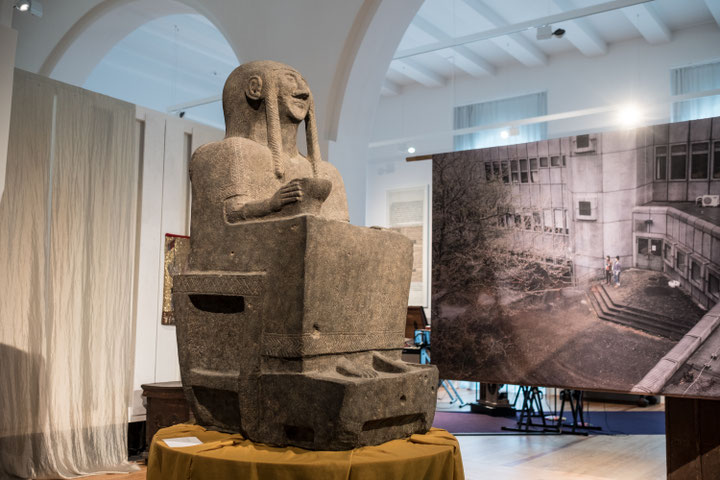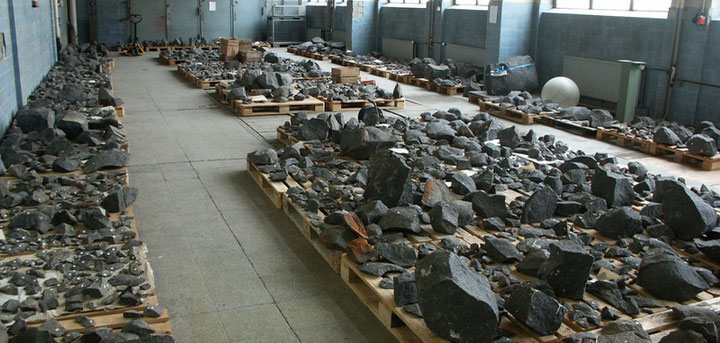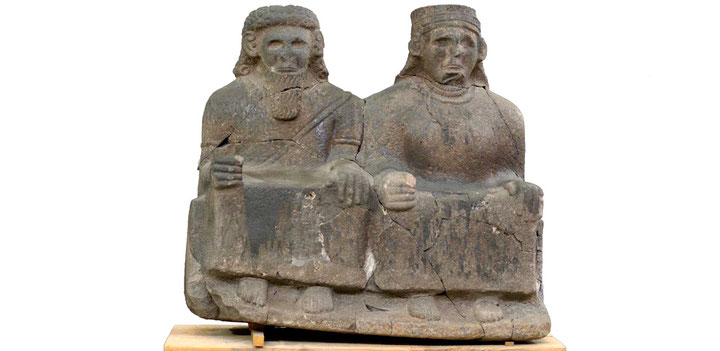Issue 2/2021 - Dinge, die uns trennen
The Enthroned Basalt Goddess
The Idiosyncrasy and Appropriability of Objects
The woman sidles around the display case with a severe gaze. What might she be interested in? The objects in the showcase are rather unspectacular: a comb made of rubber, a shard of Meissen porcelain painted with chinoiseries, and an antique clay disc with a palmette motif. The display case is designed for experimentation. It is located behind the scenes at the Museum für Kunst und Gewerbe in Hamburg. This area is off-limits to the general public – as an experimental laboratory for high-flying curatorial flights of fancy (or visions that come crashing down).
It is a familiar experience for anyone who works in museums or exhibitions: you develop interconnections, be they conceptual, aesthetic or historical, and set about pinning these linkages down and giving them shape with appropriate objects. However, the objects refuse to respond to the argument. They remain silent, acting as if they had nothing to say to each other, as if they had absolutely no desire to contribute to the curatorial construction. Instead, they set in motion entirely different chains of argumentation: unforeseen variants that would never have occurred to the curator. If you want to try out something like this, to trigger such unintended associations, you need a room behind the scenes with an experimental display case. And that’s what the woman is now circling around.
We can’t ask her what she finds so interesting about the display case. She has just arrived from Syria and speaks Kurdish and Turkish, while we speak neither. She is not alone, though, as she came to the museum with a group of women who live in Hamburg. They are all committed to political recognition of a de facto autonomous region in north-eastern Syria. This region is called “Rojava”, which in Kurdish means “west” or “sunset”.1 However, the women immediately add a qualifier, explaining that this term has some shortcomings. They note that the point is not to claim the territory solely for Kurds. Various ethnic and religious groups, they explain, live in Rojava. The political interest of the activists visiting the museum is peaceful coexistence. That calls for local self-government, but above all for political empowerment of women from all walks of life.2
One of the Rojava activists from Hamburg subsequently translates our question. The reply from the Kurdish woman is rather philosophical. She was pondering how cultural heritage is addressed, both in Syria and here in Germany. She asks if we realise that it is mainly the YPG units who are in charge of protecting archaeological sites?3 No, we didn’t know that; we are only aware of iconoclastic excesses by “Islamic State”. Yes, the woman comments, it’s not surprising that we don’t know about it. After all, she said, the Kurdish associations had no interest in bringing this issue into the public eye and thus drawing IS troops’ attention to these locations. She explained that she had wondered, standing in front of the display case – now that she is no longer deployed in the war zone – what these objects actually mean or what it signifies to save, preserve, store, and display objects from the past and to relate to them for whatever reasons and motives.
This is a profound question, to which there is no simple answer. It doesn’t make it any more straightforward that this issue is raised in the middle of a European museum, and a museum of applied arts, to boot, which, as a child of the 19th-century World’s Fairs, has a virtually unmanageable mountain of stuff (from the sublime to the completely irrelevant).4
The group of Kurdish activists did not stray into the museum by chance on that day – the episode, incidentally, took place in 2017. They had been invited to participate in an exhibition entitled Mobile Welten (Mobile Worlds), which aimed to build a bridge between the transcultural reality of life in post-migrant Germany and a collection in which many objects are not simply identical with themselves, but are instead prismatic in nature, in other words, they recount here and there, yesterday and today, and perhaps also tomorrow. Who, we thought, needs categories like “Islam”, “Modernity”, “Middle East” or “Antiquity” when it is so much more entertaining and instructive to trace the objects’ unpredictable migrations?5
Initially, the activists had toyed with the idea of contextualizing the Mesopotamian objects in the Hamburg museum collection: with a small documentary archive of images and text on the current situation in northern Syria. However, it became crystal-clear when this documentary archive was being put together in that room behind the scenes mentioned above: documentary evidence, which works quite well in the normal world, is transformed as if by magic into fiction in the museum space. It becomes aesthetic, which that is not what either we or the activists wanted. That meant a different approach was needed, tapping into the mobilizing energy of the museum objects per se.
An initial candidate for such mobilization was in fact in Berlin: the Enthroned Goddess. That name is given to this figure because nothing is actually known about it, except that it is an approximately 3,000-year-old basalt funerary figure with braids. The goddess figure was discovered and excavated in the early 20th century in northern Syria, at Tell Halaf, a hill close to what is now the Turkish-Syrian border. It was found by a German diplomat and amateur archaeologist, Max von Oppenheim, who at the time supplied the German Empire with information about the Orient from his office in Cairo. His Jewish heritage meant Oppenheim was denied an official career in the German diplomatic service with its anti-Semitic leanings. That however did not stop him from undertaking unofficial missions on his own initiative and at his own expense.
As part of such a mission, in 1899 Oppenheim explored a possible route for the Baghdad Railway – a massive infrastructure project intended to connect Berlin with (what was then still) Constantinople, Aleppo, Baghdad and finally Basra by means of a railway line. (It is scarcely possible to overestimate the geostrategic importance of such a railway line, which would have given Germany access to the Red Sea. As well as transporting troops and commodities across Europe and the Middle East, the German presence on the Red Sea would have posed an acute threat to British control over their colonies.)6
During his fact-finding mission, Oppenheim’s attention was drawn to Tell Halaf and in 1911 he began uncovering its archaeological treasures on a grand scale. The First World War initially interrupted the excavations. Oppenheim returned to Cairo, to the Intelligence Bureau for the East, and pursued the ambitious plan of inciting the Muslim population to a jihad against the British (in Egypt) and the Russians (in the Caucasus).7 He managed to continue the excavations at Tell Halaf in the mid-1920s, by which time Syria was under a French mandate. Along with other sculptures and architectural fragments, the Enthroned Goddess made her way to Berlin. The state museums there refused to include the finds in their collections and Oppenheim consequently decided to found his own institution: the Tell Halaf Museum. Set up in an empty factory building, this museum bore witness to an uninhibited desire for idiosyncrasy (and thus anticipated artistic museum projects such as those of Marcel Broodthaers, Claes Oldenburg, or Allan Sekula). Visitors like Carl Einstein and Samuel Beckett appreciated the Mesopotamian Gesamtkunstwerk in the middle of Berlin, while Agatha Christie reported being rather bored during her museum tour. In her diary she also mocked Oppenheim’s fetishistic demeanour towards the basalt goddess with the braids, which he venerated as “my beautiful Venus”.8
The divinity was also close to the hearts of Kurdish activists, albeit for different reasons. She manifested female counter-power – triumphing over the misogynistic violence of the self-proclaimed warriors of God with their mindless interpretation of the Koran. In the context of Mobile Worlds, was there perhaps a way to gain access to the goddess figure? Could it be possible to imagine something like a small-scale restitution, by way of integrating the goddess into an exhibition created with activist involvement? It should be added that the activists take the 3,000-year-old basalt monuments literally: as models of an alternative present. The Seated Couple, for example, another of Oppenheim’s finds, inspires symmetry in gender politics in northern Syria; the autonomous region’s constitution stipulates that every government office must have twofold leadership: a man and a woman. Archaeological artifacts are therefore more than mere “cultural heritage”. They are, in fact, agents of political change. They point to a future that comes from the past.
Clearly, treating archaeological artifacts like that upsets the chronological perspective of Western museum standards. I beg your pardon, an antiquity that comes from the future? It is also obvious that the artefacts are quite deliberately overlaid with projections and ardently appropriated. No one has the slightest idea what the Goddess or the Seated Couple once meant. It is precisely this uninterpretability, however, that helps allow the artefacts to become replete with idiosyncrasy, with their own history, and become contemporary ...
The Tell Halaf Museum was completely destroyed during a night of bombing in Berlin in 1943. While the volcanic basalt stayed reasonably cold heat despite the heat from the phosphorus, the water used to extinguish the fire made the sculptures shatter. Oppenheim’s assistants at least managed to salvage the thousands of rock fragments and store them in the Pergamon Museum’s depot. These statues with dreams that span broad swathes of time slumbered through the GDR and were only unearthed again in 2001 when they were first lavishly reconstructed and then restored. In 2011, the Staatliche Museen zu Berlin presented the Mesopotamian artefacts in a show entitled Die geretteten Götter aus dem Palast vom Tell Halaf (EN title: The Tell Halaf Adventure).9 The restoration team made no attempt to cover up the enormous damage the objects had suffered . Today, the artifacts seem all the more full of pathos with their visible fragility, although that pathos attaches less to the artifacts themselves than to the heroic act of their restoration, complete with its state-foundational role. The goddess remains spellbound in the Berlin museum cosmos.
De facto appropriation of the goddess by the Rojava activists was therefore out of the question, let alone a return of the figure to northern Syria. War is raging there, with archaeological sites now under attack by the Turkish army rather than IS. However, Oppenheim was a thorough man, and in the course of dividing up the finds, he had plaster casts made while the objects were still on site. The cast of the goddess, now kept in the Staatliche Museen’s plaster cast workshop, shows the sculpture in what you might call its original state – before it was destroyed. In addition, the casts are truly virtuoso pieces that also reproduce the feel of the sculpture, its basalt surface, which appears deceptively real thanks to a layer of sand. The Rojava activists agreed that this cast of the unscathed goddess was a much better fit for the feminist cause than the pathos-ridden woman composed from rubble woman from the Vorderasiatisches Museum. The goddess developed into a photo op for many in the Kurdish-Syrian community in Hamburg and beyond.
As chance would have it, in addition to the Berlin museums and Mobile Worlds, the Enthroned Goddess is currently also making an appearance at The Metropolitan Museum of Art in New York. In his installation Alien Property, the Lebanese artist Rayyane Tabet grapples with Oppenheim’s activities at Tell Halaf.10 Tabet has a unique form of access to the topic because his great-grandfather worked as Oppenheim’s secretary – appointed by the French Mandate government, which couldn’t be sure exactly what the German ex-diplomat was up to in the Syrian desert. As is generally acknowledged, 19th and early 20th-century European empires’ interest in archaeology was about more than just objects from the distant past, for it was often linked to geological, ethnographic and military reconnaissance, in short: to espionage activities.
Tabet does not concentrate primarily on the Enthroned Goddess per se. His focus is on the panels with reliefs from Tell Halaf’s Aramaic palace, which are now scattered to the four winds thanks to similarly complex twists of fate as those described above. Since some of these relief slabs are part of The Met’s collection, Alien Property offers the museum a chance to spice up its antiquities collection. The (original) figure of the goddess squats somewhat forlornly amidst the contemporary installation. While she doesn’t have to play “beautiful Venus” here or minister to the Berlin Republic’s rubble aesthetic, the question does arise of whether this journey does her any good. In this context, the goddess merely functions as a pawn in a clever, post-conceptual structure that does not however abandon the comfort zone of museological discourse. Is that such a bad thing? Hard to say. Does the goddess deserve better? Most certainly.
Translated by Helen Ferguson
[1] In 2017/18, the Autonomous Administration of North and East Syria controlled around 50,000 km2, where some 4.6 million people of various ethnicities lived, many of them refugees from the Syrian civil war. After the invasion of the region by the Turkish military (2018/19) and the simultaneous withdrawal of US troops, the Autonomous Administration and its combat units were forced to come to an agreement with the Syrian government.
[2] The Hamburg activists who worked on Mobile Worlds belong to the Foundation of Free Women in Syria (WJAS).
[3] The YPG (Kurdish People’s Defense Units) form the de facto army in northern Syria and were part of the Syrian Democratic Forces (DKS) established by the US in the fight against IS.
[4] Museums of applied arts [sometimes also described as museums of art and design], above all what is now the Victoria & Albert Museum in London, have more than just ideological ties to the World’s Fairs. Justus Brinckmann, founding director of the Museum für Kunst und Gewerbe in Hamburg went on a shopping spree at the World’s Fairs in Vienna (1873) and Paris.
[5] The exhibition Mobile Welten (Mobile Worlds) was presented from April to October 2018 at the Museum für Kunst und Gewerbe (MKG) in Hamburg. It was part of a project jointly realised with the European University Viadrina (Frankfurt an der Oder) and the Johann Wolfgang Goethe University (Frankfurt am Main). Many chapters of this exhibition had previously been developed at Johann Jacobs Museum (Zurich).
[6] The Baghdad Railway project operated from 1910 to 1940, initially with technological and financial support from the German Empire, which had developed a more pronounced interest in the Mesopotamian oil fields on the eve of the First World War. Cf. Sean McMeekin, The Berlin-Baghdad Express: The Ottoman Empire and Germany’s Bid for World Power, 1898-1918. London: Penguin 2011.
[7] Cf. Stefan M. Kreutzer, Dschihad für den deutschen Kaiser: Max von Oppenheim und die Neuordnung des Orients (1914-1918). Graz: Ares 2012.
[8] Agatha Christie visited the Tell Halaf Museum with her husband, archaeologist Max Mallowan.
[9] Cf. Die geretteten Götter aus dem Palast vom Tell Halaf, (ed.) Vorderasiatisches Museum der Staatlichen Museen zu Berlin on the occasion of the eponymous 2011 exhibition at the Pergamonmuseum. Regensburg: Verlag Schnell & Steiner 2011.
[10] See https://www.metmuseum.org/exhibitions/listings/2019/rayyane-tabet-alien-property or https://www.metmuseum.org/art/metpublications/Rayyane_Tabet_Alien_Property.




